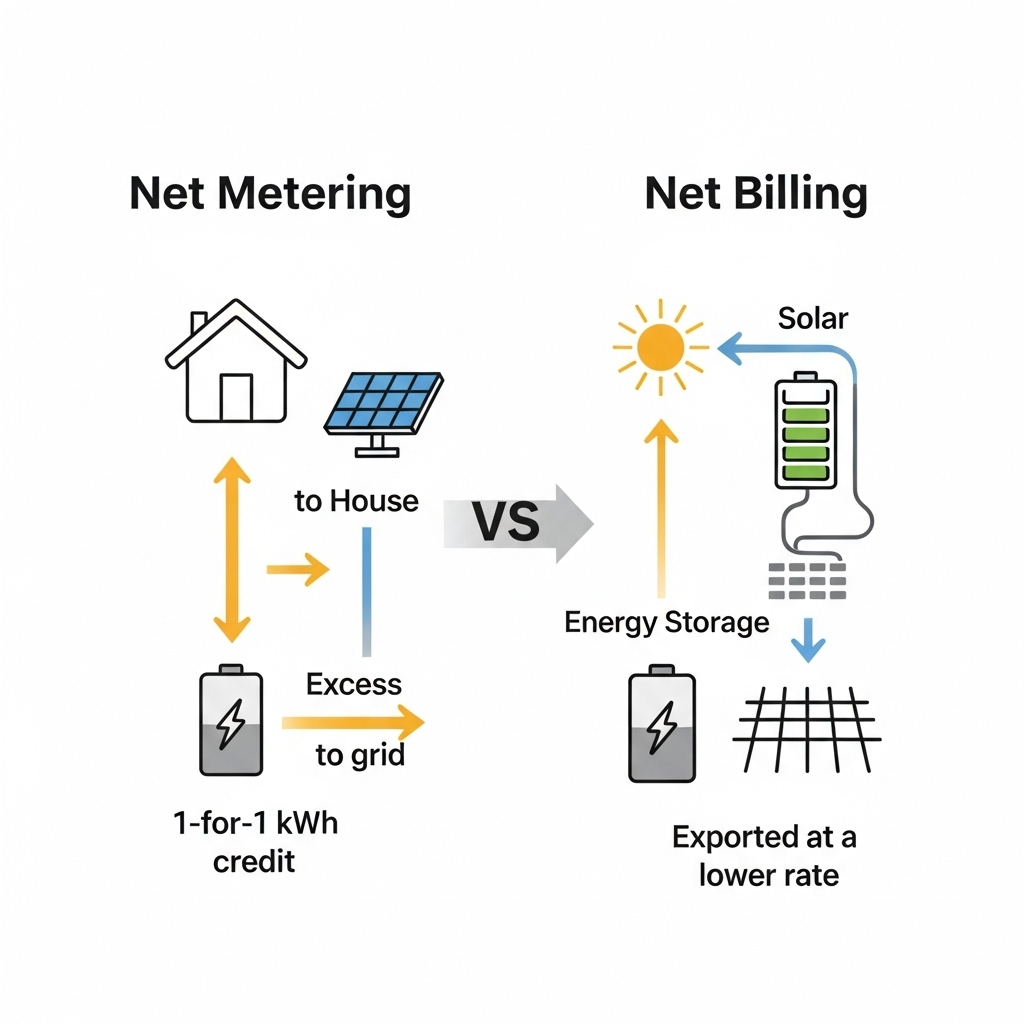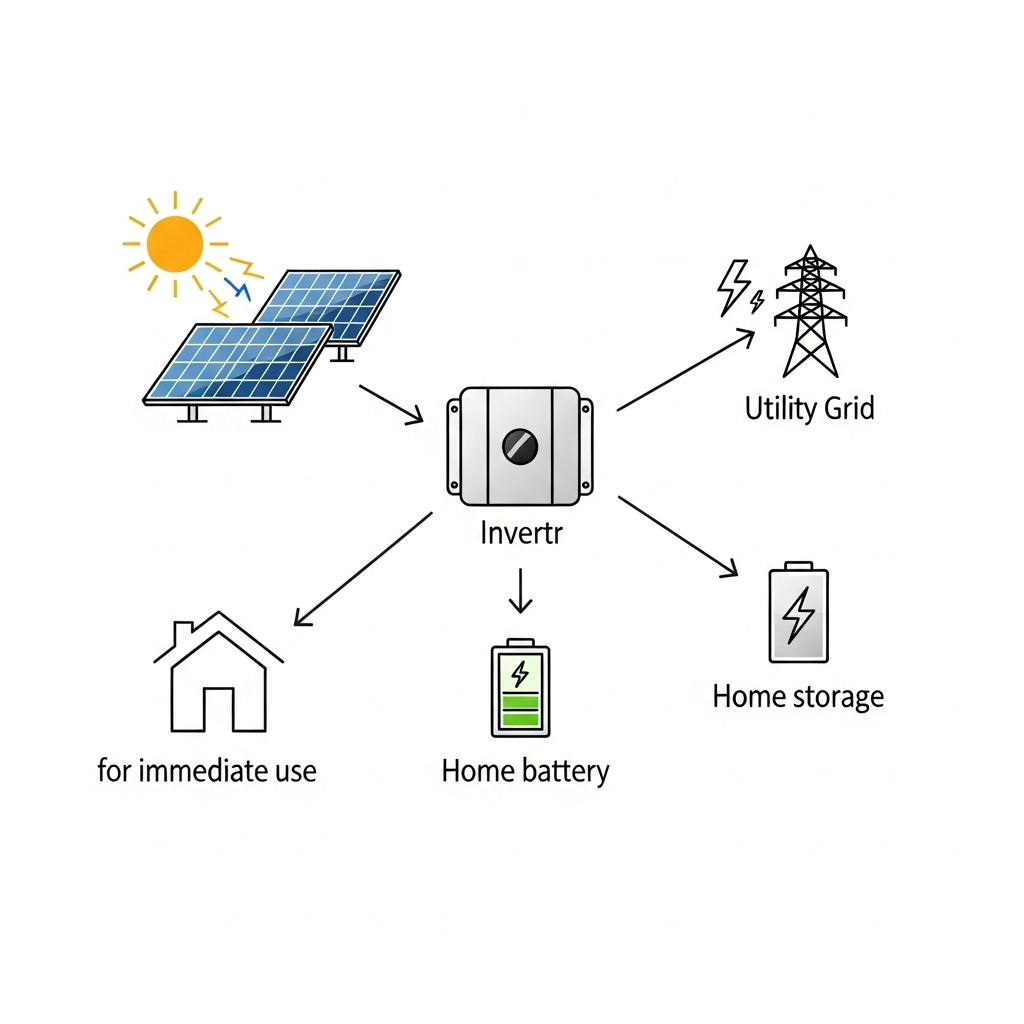When your solar panels generate more electricity than your home is using, that surplus power doesn't go to waste. It flows back to the utility grid. How you are compensated for this exported energy is determined by a set of rules often called solar export compensation. Understanding these policies is crucial for calculating the financial return of your solar energy system. This guide clarifies the most common models: Net Metering, Net Billing, and other export credit structures, so you can understand how you get value from every kilowatt-hour you produce.
What is Net Metering? The Original Solar Incentive
Net metering was one of the first policies designed to encourage homeowners to adopt solar power. Its simplicity made it popular and effective in kickstarting the residential solar market.
How Net Metering Works
Think of net metering as a 1-for-1 swap. For every kilowatt-hour (kWh) of electricity your solar system exports to the grid, you receive a credit for one kWh that you can pull from the grid later. For example, if your panels overproduce by 10 kWh during a sunny afternoon, you can use 10 kWh from the grid that evening at no cost. Your utility meter effectively spins backward when you export power, and forward when you import it. At the end of the billing period, you only pay for your 'net' energy consumption—the difference between what you used from the grid and what you sent to it.
The Pros and Cons of Net Metering
The primary advantage of net metering is its straightforward value proposition for the solar owner. It provides a clear and direct path to significant savings on electricity bills. This strong incentive has been a major driver of solar adoption. However, as more homes install solar, some utilities and regulators argue that this 1:1 credit system doesn't account for the costs of maintaining the grid infrastructure. This debate over cost-sharing is a key reason many regions are exploring alternative compensation models.
The Shift to Net Billing: A New Compensation Model
As solar becomes more widespread, many jurisdictions are transitioning from net metering to net billing. This model changes the financial equation for exported solar energy.
Defining Net Billing
Under net billing, the 1:1 swap is replaced with a two-part transaction. You sell your exported solar power to the utility at a specific 'export credit' rate, which is often based on the wholesale or 'avoided cost' of energy. Then, when you need to draw power from the grid, you buy it at the standard retail rate. The key difference is that the export rate is almost always lower than the retail rate. Instead of an energy credit, you receive a monetary credit on your bill for the power you export.
Net Metering vs. Net Billing: A Direct Comparison
The differences between these two policies directly impact the financial payback of a solar system. Understanding them is key to making an informed decision.
| Feature | Net Metering | Net Billing |
|---|---|---|
| Credit Value | 1 kWh exported = 1 kWh credit (Retail Rate) | Credit is a monetary value, typically lower than the retail rate (Wholesale/Avoided-Cost Rate) |
| Financial Return | Generally higher for the system owner, as exports offset imports at the full retail price. | Lower direct return from exports, encouraging self-consumption of solar energy. |
| Grid Impact | Critics argue it may not cover grid service costs, potentially shifting them to non-solar customers. | Designed to more accurately reflect the value of solar to the grid at the time of generation. |
| Policy Trend | The original model, now being phased out in many mature solar markets. | The emerging standard in many regions updating their renewable energy policies. |
Why Are Policies Changing?
The move toward net billing is largely driven by the increasing penetration of solar energy on the grid. As utilities manage a power grid with more distributed energy resources, they adjust policies to ensure grid stability and fair cost allocation. As a study from the International Energy Agency (IEA) highlights, markets often evolve from simple metering policies to more complex structures as the number of solar installations grows and their impact on the grid becomes more significant.
Understanding Export Credits and Tariff Structures
Beyond the basic models, other rate designs and technologies add layers to the solar compensation landscape. These can create both challenges and opportunities for system owners.
Beyond Simple Credits: Time-of-Use (TOU) Rates
Many utilities use Time-of-Use (TOU) rates, where the price of electricity changes throughout the day. Power is typically more expensive during 'peak' hours of high demand (like late afternoons and evenings) and cheaper during 'off-peak' hours. When combined with net billing, TOU rates can make exporting your solar power during sunny peak afternoon hours more valuable than exporting it in the morning.
The Role of Value of Solar (VOS) Tariffs
A Value of Solar (VOS) tariff is an even more granular approach. Instead of a fixed export rate, it attempts to calculate the comprehensive value of solar energy at a given time. This calculation can include the avoided cost of electricity, the value of reduced strain on transmission lines, and even environmental benefits. Early policy discussions, as detailed in an IEA report on next-generation renewables, explored VOS tariffs as a successor to net metering, aiming to create a more precise compensation mechanism.
The Strategic Advantage of Energy Storage
With policies like net billing and TOU rates, exporting all your surplus solar power is not always the best financial strategy. This is where a home battery storage system becomes a powerful tool. Instead of exporting excess solar for a low credit, you can store it in your battery. Later, when grid electricity is expensive, you can use that stored energy to power your home, avoiding high utility charges. This strategy is known as self-consumption. To effectively implement this, a solid grasp of system performance is vital. Understanding metrics like your battery's Depth of Discharge (DoD) and Round-Trip Efficiency (RTE) is essential for calculating actual savings. A detailed guide on solar storage performance metrics offers the technical knowledge needed to optimize your system for maximum financial benefit.
Navigating Your Local Solar Policy Landscape
Renewable energy policy is highly localized. The rules that apply to your neighbor in the next state, or even the next town, could be completely different from yours.
How to Find Your Local Utility's Policy
The best source of information is your local utility. Visit their website and search for terms like 'interconnection,' 'net metering,' 'distributed generation (DG),' or 'renewable energy tariff.' These documents outline the specific rules, rates, and technical requirements for connecting a solar system to the grid. State-level Public Utility Commissions (PUCs) or Public Service Commissions (PSCs) also regulate these policies and are another valuable resource.
Making the Right Financial Decision
The ideal solar compensation structure depends on your household's energy usage patterns, the size of your solar array, and your local utility rates. As policies continue to evolve, integrating a battery storage system can help future-proof your investment. Data from the U.S. Energy Information Administration consistently shows that energy storage deployment is accelerating, a trend driven by its ability to provide stability and value in a grid with high levels of renewables.
Disclaimer: This article is for informational purposes only and does not constitute financial or legal advice. Consult with a qualified professional and check your local utility regulations before making any investment decisions.
Your Path to Energy Independence
The world of solar export compensation is clearly moving from simple, one-size-fits-all models to more dynamic, value-based systems. While this adds complexity, it also creates opportunities. By understanding the policies in your area and leveraging technologies like home energy storage, you can design a system that maximizes your savings and energy independence. This knowledge empowers you to take control of your energy future and make the most of your investment in clean power.
Frequently Asked Questions
What happens if I produce more energy than I use over a whole year?
This depends on your utility's specific rules for its 'true-up' period. At the end of a 12-month cycle, some utilities will pay you for your net excess generation, though often at a low wholesale rate. Other utilities may simply reset your accumulated credits to zero without any cash payment. It is critical to check your local policy.
Is Net Metering going away completely?
While the trend in many mature solar markets is a transition away from traditional 1:1 net metering, the policy still exists in many places. However, it is wise to anticipate future changes. New solar customers in many states are now being enrolled in net billing or other alternative tariffs from the start.
How does a battery help with Net Billing?
A battery dramatically improves the economics of a solar system under net billing. It allows you to store your excess solar energy instead of selling it to the grid for a low credit. You can then use this stored, 'free' energy during peak hours when electricity from the grid is most expensive. This strategy, known as self-consumption or load shifting, directly increases your energy independence and financial savings.





Leave a comment
All comments are moderated before being published.
This site is protected by hCaptcha and the hCaptcha Privacy Policy and Terms of Service apply.